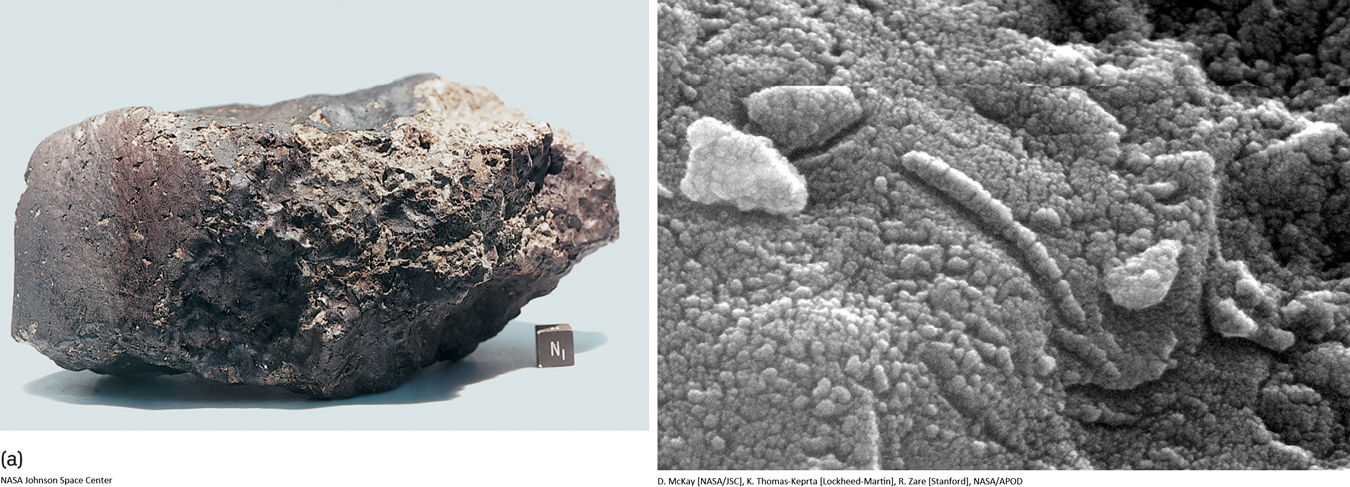8-3 Meteorites from Mars have been scrutinized for life-forms
What would be sufficient evidence for you to believe that life exists on another planet beyond Earth? Would it have to be a message of greetings and salutations from an intelligent being? Is finding fossils of bacteria and plankton on another planet sufficient? While spacecraft can carry biological experiments to other worlds such as Mars, many astrobiologists look forward to the day when a spacecraft will return Martian samples to laboratories on Earth. Until that day arrives, we have the next best thing: A dozen or so meteorites that appear to have formed on Mars have managed to make their way to a variety of locations on Earth.
These meteorites are called SNC meteorites after the names given to the first three examples found (Shergotty, Nakhla, and Chassigny). What identifies SNC meteorites as having come from Mars is the chemical composition of trace amounts of gas trapped within them. This composition is very different from Earth’s atmosphere but is a nearly perfect match to the composition of the Martian atmosphere found by the Viking Landers.
How could a rock have traveled from Mars to Earth? When a large piece of space debris collides with a planet’s surface and forms an impact crater, most of the material thrown upward by the impact falls back onto the planet’s surface. But some extraordinarily powerful impacts produce large craters on Mars, roughly 100 km in diameter or larger. These tremendous impacts eject some rocks with such speed that they escape the planet’s gravitational attraction and fly off into space.
There are numerous large craters on Mars, so a good number of Martian rocks have probably been blasted into space over the planet’s history. These ejected rocks then go into elliptical orbits around the Sun. A few such rocks will have orbits that put them on a collision course with Earth, and these are the ones that scientists find as SNC meteorites.
Question
ConceptCheck 8-7: Why are scientists convinced that these SNC meteorites actually came from Mars and not from our Moon?
Martian Meteorites May Show Evidence of the Presence of Liquid Water
Using a radioactive age-dating technique, scientists find that most SNC meteorites are between 200 million and 1.3 billion years old, much younger than the 4.56-billion-year age of the solar system. But one SNC meteorite, denoted by the serial number ALH 84001 and found in Antarctica in 1984, was discovered in 1993 to be 4.5 billion years old (Figure 8-10a). Thus, ALH 84001 is a truly ancient piece of Mars. Analysis of ALH 84001 suggests that it was fractured by an impact between 3.8 and 4.0 billion years ago, was ejected from Mars by another impact 16 million years ago, and landed in Antarctica a mere 13,000 years ago.

Although we have several other meteorites that we are certain came from the surface of Mars, what makes ALH 84001 special is that it is the only known specimen of a rock that was on Mars during the era when liquid water most likely existed on the planet’s surface. Scientists have therefore investigated its chemical composition carefully, in the hope that this rock may contain clues to the amount of water that once flowed on the Martian surface. One such clue is the presence of rounded grains of minerals called carbonates, which can form only in the presence of water.
197
In 1996, David McKay and Everett Gibson of the NASA Johnson Space Center and several collaborators reported the results of a two-year study of the carbonate grains in ALH 84001. They made three remarkable findings. First, in and around the carbonate grains were large numbers of elongated, tubelike structures resembling fossilized microorganisms (Figure 8-10b). Second, the carbonate grains contain very pure crystals of iron sulfide and magnetite. These two compounds are rarely found together (especially in the presence of carbonates) but can be produced by certain types of bacteria. Indeed, about one-fourth of the magnetite crystals found in ALH 84001 are of a type that on Earth are formed only by bacteria. Third, carbon-based molecules are present—just the sort, in fact, that result from the decay of microorganisms. McKay and Gibson concluded that the structures seen in Figure 8-10b are fossilized remains of microorganisms. If so, these organisms lived and died on Mars billions of years ago, during the era when liquid water was abundant.
Are McKay and Gibson’s conclusions correct? Their claims of ancient life on Mars are extraordinary, and such claims necessarily require extraordinary proof within the domain of science. With only one rock like ALH 84001 known to science so far and because fully compelling proof is hard to come by, many scientists are skeptical. They argue that the structures found in ALH 84001 could have been formed in other ways that do not require the existence of Martian microorganisms. Future spacecraft may help resolve the controversy by examining rocks on the Martian surface. For now, the existence of microscopic life on Mars in the distant past remains an open question.
Question
ConceptCheck 8-8: Why do astrobiologists test meteorites for the presence of magnetite and pure iron sulfide crystals?